The “decision-making ability*1/attentiveness,”
which are parts of the cognitive functions of middle and older-aged persons with no exercise habits, have improved.
Results of animal studies have reported on the effects of 6-MSITC on cognitive functions. *2,3 As exercise routines improve brain functions *4, 5, 37 healthy middle and older age males and females (Placebo group: 18, Wasabi-derived 6-MSITC Group: 19) with no routine exercise habits and with self-awareness of forgetfulness were given wasabi-derived 6-MSITC to investigate the effects on the brain functions.
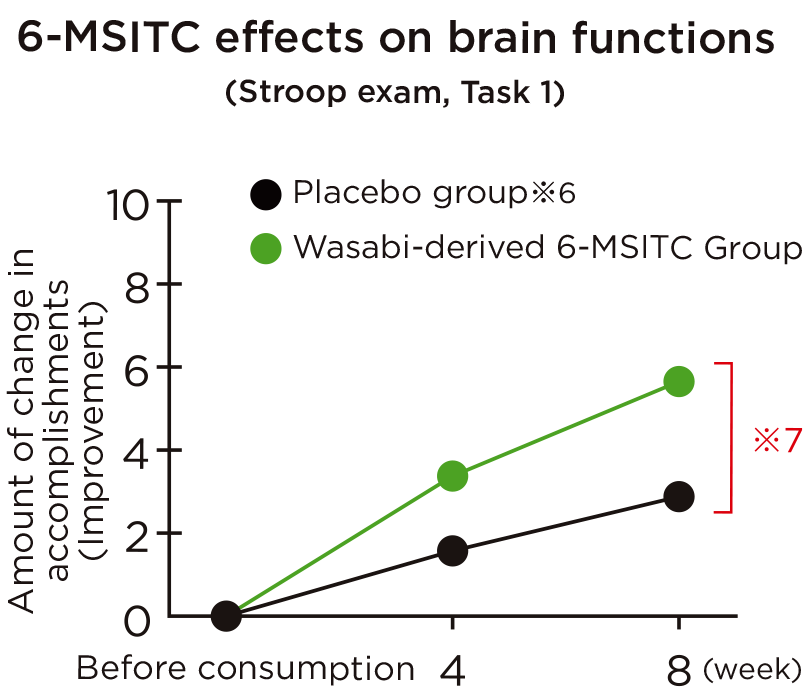
As a result, as displayed in the diagram to the left, the variations in the eighth-week indicated that the wasabi-derived 6-MSITC group showed improvements compared to the placebo group*6, and some cognitive functions such as decision-making ability (ability to accurately process information) and attentiveness showed improvements. *8
The evaluation of attention forms a central part of cognitive functional evaluation. Attention is not a single function, but rather is connected to various cognitive functions and plays a key role in supporting learning, memory and executive functions, and the activity of working memory.
Cellular tests report that 6-MSITC has “antioxidant effects” *9 by inhibiting the production of active enzymes and also has “platelet aggregation inhibiting effects.” *10 It is possible that these effects limit the damages on the cells, thereby contributing to improved cognitive functions.
- *1
- Ability to correctly process information
- *2
- Protective Effects of 6-(Methylsulfinyl)hexyl Isothiocyanate on A 1-42-Induced Cognitive Deficit, Oxidative Stress, Inflammation, and Apoptosis in Mice. Int. J. Mol. Sci. 19,2083-2102(2018)
- *3
- Neuroprotection by 6-(methylsulfinyl)hexyl isothiocyanate in a 6-hydroxydopamine mouse model of Parkinson’s disease. Brain Reserch: 1589,93-104(2014)
- *4
- Correlation between cognitive functions and exercise/physical activity in the elderly, 25th Health and Medical Science Research Grant Papers, 129-136 (2010)
- *5
- Acute moderate exercise elicits increased dorsolateral prefrontalactivation and improves cognitive performance with Stroop test. Neuroimage, 50, 1702-1710(2010)
- *6
- A placebo is a drug that contains no active ingredient (has no medicinal effect). It looks like a real drug, but does not contain any medicinal ingredients. It is a fake drug.
- *7
- p < 0.05 (2 samples, t-test)
- *8
- The effects of wasabi root extract rich in 6-(methylsulfinyl)hexyl isothiocyanateon neurocognitive functions in cognitively intact middle-aged and older adults: a randomized, double-blind, placebo-controlled trial. Jpn Pharmacol Ther. 47, 275-286 (2019). Report for systematic review
- *9
- Inhibitory Effects of 6-Methylsulfinylhexyl Isothiocyanate on Superoxide Anion Generation from Differentiated HL-60 Human Promyelocytic Leukemia Cells. Food Science and Technology Research, 23, 343-348(2017)
- *10
- All About Wasabi, Japan Scientific Societies Press (2006)
The Many Benefits of Wasabi Sulfinyl
Wasabi Sulfinyl can be expected to have anti-aging effects in its prevention of active enzyme production, thereby preventing the onset of hay fever, cancer, lifestyle-related diseases, as well as reduced function in various cells and tissues. It is also confirmed to have effects on reducing oxidative stress after intense exercise, beautifying skin by improving blemishes and freckles, as well as an anti-inflammatory effect that eases knee pain, and an inhibiting effect on platelet aggregation. It is expected to have an effect on improving blood flow as well.
The Antioxidant Functions of Wasabi Sulfinyl and Its Effect On Brain Neurons
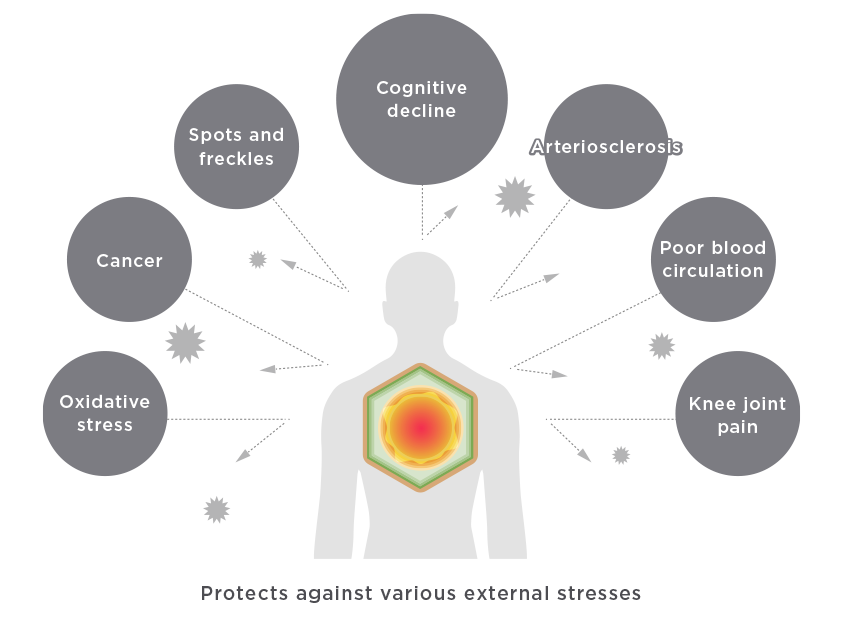
Antioxidant benefits
Common antioxidants such as polyphenols work directly on free radicals to remove them. However, the antioxidant effect of wasabi sulforaphane found in the plant works in a completely different way, acting directly on cells to prevent them from producing free radicals in the first place. In other words, it enhances the cells' inherent antioxidant capabilities. In a test conducted on mice, the production of free radicals was curbed by 48%, and when wasabi sulphorafane was applied once to rat cells, it led to the increased expression (for over 24 hours) of a protein that protects the cells from oxidative stress.
Moreover, one substance that plays a critical role in the process of protecting cells is NRF2. NRF2 is activated by oxidative stress caused by free radicals, and acts by protecting cells. Recent findings have revealed that a lack of NRF2 impairs the body's ability to withstand environmental and other external stressors, as well as makes it more susceptible to internal stressors like free radicals. Moreover, experiments using mice have already demonstrated that Wasabi-sulfinyl®, which contains wasabi sulforaphane, effectively activates NRF2.
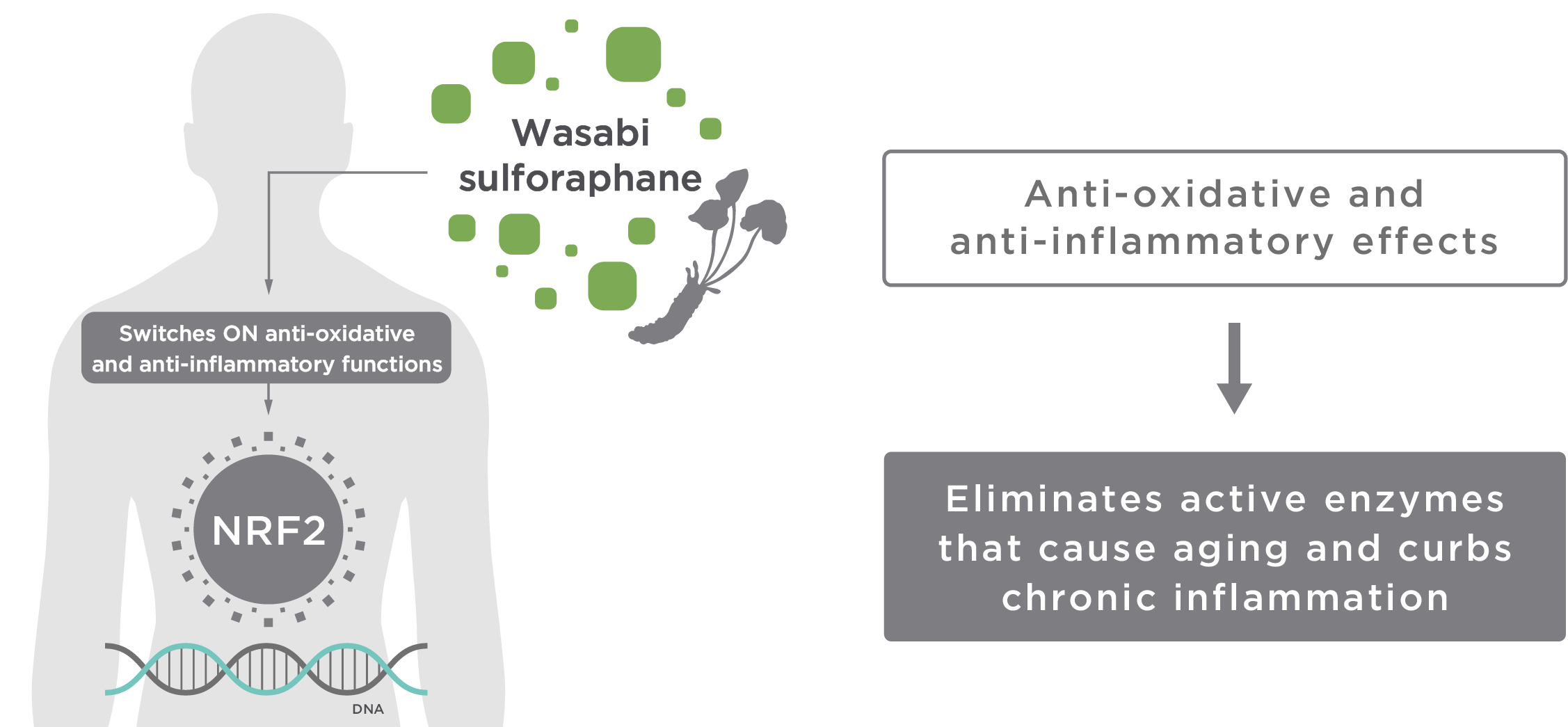
*The image describes the possible effects of wasabi sulphorafane based on clinical and non-clinical data.
This is not intended as a claim of actual outcomes in humans from the use of wasabi sulphorafane.
About free radicals(reactive oxygens) and antioxidants.
However, excessive occurrence of this phenomenon can damage cells and cause various diseases such as cancer, cardiovascular disease, and lifestyle disease. While the body contains internal antioxidant functionality to protect cells from free radicals, antioxidants further assist in this process. The body's antioxidant ability gradually declines with age, and undergoes a rapid decline starting in the 40s.
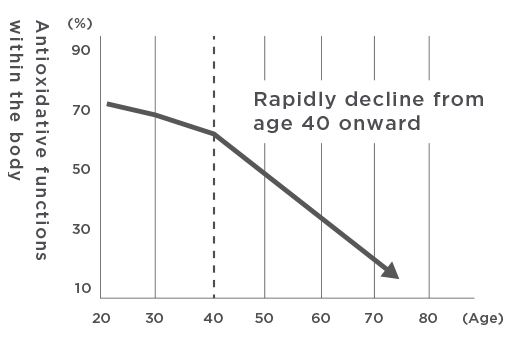
SOD:Superoxide dismutase Blood 1990 76 : 835-841
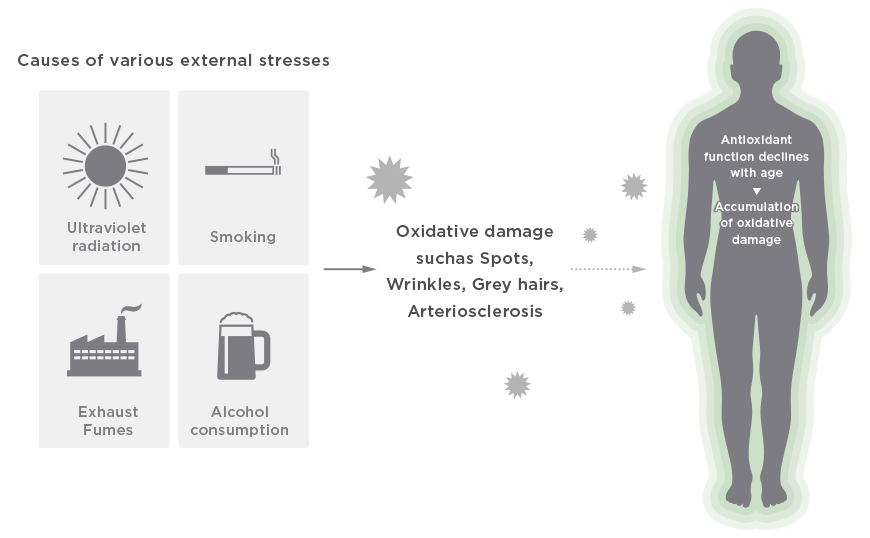
About wasabi
Wasabi (scientific name: Wasabia japonica Matsumu.) is a Japanese plant in the Brassicaceae family that grows in streams deep in the mountains. This vegetable is considered good for the body, but it has a very strong and pungent taste, making it impossible to eat in large quantities. Food-grade wasabi sold in tubes and intended to be stored at room temperature contains many preservatives and additives, with the actual quantity of wasabi sulphorafane being quite minimal. Wasabi is a plant native to Japan and is believed to have been used as a source of nutrition during the Asuka period (550-710 CE). It is also used as a condiment with sushi and sashimi because of its disinfectant and antibacterial properties *11.There are a number of ongoing tests today into the efficacy of wasabi for various uses.



